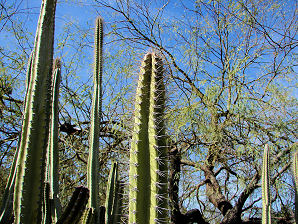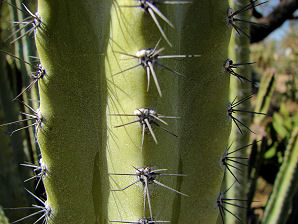Xeriscape Landscaping Plants For The Arizona Desert Environment.
Pictures, Photos, Information, Descriptions,
Images, & Reviews.
Cactus.
Senita Cactus, Pachycereus schottii.
We Are Proud Of Our SafeSurf Rating!
Click On Any Of The Following Links By Amazon.Com
For Books, & Videos About Wildflowers Of Arizona & The Southwest USA. No Obligation!
| Senita Cactus, Pachycereus schottii. Photo Taken February 17, 2006. |
|---|
 |  |
| Senita Cactus | Pachycereus schottii |
|---|
Senita Cactus.
We wish to thank Wikipedia, the free encyclopedia for some of the information on this page. We share images and information with Wikipedia. Columnar, basally branching, slow growing up to 12 feet tall. Stems 4 to 8 inches in diameter; 5 to 10 ribs; areoles on the bottom part of the stems are woolly, oval, 1/8 to 1/4 inch wide, with one to 15 spines, 1/16 to 1/3 inch long; upper areoles 1/3 to 6/10 inch wide, 20 to 75 spines , 1 1/4 to 4 inches long. Very attractive for landscape use. It is also less frost resistant, and should be protected below 25�F The senita blooms at night at the end of the spring in the 'hairy' part of the stems. The flowers are light pink, up to 1 2/3 inches in diameter. They close around mid-morning. The Senita blooms most of the year, mainly from April to September. The edible fruit is red, with a red pulp. Can be seen in its native habitat growing at the Organ Pipe Cactus National Monument, AZ.
Quick Notes:
Height: Height to about 12 feet. Spreading to about 8 feet.
Flowers: Light pink, up to 1 2/3 inches in diameter.
Fruit: Red, with a red pulp.
Blooming Time: April - September.
Stems: Green stems are slim, lightly pruinose with broad rounded protuberances roughly branched and poorly defined. The areoles are few and insignificant.
Found: Native to Mexico in Baja California (Norte), Baja California Sur, & Sonora. Also in the southern part of Arizona. The USDA claims it is native to the USA (AZ). In La Paz, & Pima Counties.
Elevation: 0 - 4,800 feet. In native areas.
Hardiness: Zone 8b is too cold in most of Arizona, except for southern Arizona. Only Hardy to 18�F. Most growers protect in winter with foam plastic cups on the tips.
Soil pH requirements:
Sun Exposure:
Habitat: Lower elevations sandy flats. It grows well in sand, sandy loam. It needs good drainage and aeration. Common xeriscape landscape plant in Arizona.
Miscellaneous: Maintenance: Low. Photos Taken At The Glendale Arizona Xeriscape Demonstration Garden, February 17, 2006.
|
We Are Proud Of Our SafeSurf Rating!
Click On Any Of The Following Links By Amazon.Com
For Books, & Videos About Wildflowers Of Arizona & The Southwest USA. No Obligation!
| © 1966 - Present, Audrey, Eve, & George DeLange |
